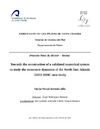Please use this identifier to cite or link to this item:
https://accedacris.ulpgc.es/jspui/handle/10553/10667
| Title: | Towards the construction of a validated numerical system to study the mesoscale dynamics of the North East Atlantic (2003-2006) | Authors: | Estrada-Allis, Sheila N. | Director: | Rodríguez Santana, Ángel Caldeira, R.M. Sangrá Inciarte, Pablo Machín Jiménez, Francisco José |
UNESCO Clasification: | 251007 Oceanografía física | Keywords: | ROMS North Eastern Atlantic Model validation Atmospheric-ocean interactions Boundary conditions |
Issue Date: | 2011 | Project: | Campaña Oceanográfica Promeca-2010 RAIA (0313RAIA1E)530 |
Abstract: | A detailed validation study has contributed to the construction of a NEAtlantic (NEA), ocean circulation model, for the 2003-2006 period. The comparisons between three model solutions, remote sensing and in situ data, focused on the study of the most dynamical processes of NEA sub-regions. Model validations include (i) comparisons with Sea Surface Temperature (SST), from AVHRR and Microwave-OI; (ii) Eddy Kinetic Energy (EKE), computed from altimetry; (iii) Temperature and Salinity profiles computed from ARGO floats, and (iv) sub-surface temperature, measured in three buoys of Puertos del Estado. Simple statistical methods were used to quantify model-data comparisons. In general, model regional solutions show a good correlation and small Root Mean Squared Error (RMSE) with SST and EKE. The main water masses were well depicted by the regional model; while the region with high salinity values, often dominated by Mediterranean Intermediate Water (MIW), was not accurately resolved. The initial condition and boundary forcing of the regional model was evaluated, particularly concerning the usage of Ocean General Circulation Models (OGCMs), as an alternative to the classical climatological forcing. The analysis of their Kolmogorov energy spectrum determined their effective resolutions and their EKE levels. Mercator global solution at 1/4?, was shown to be an adequate OGCM solution for studying the 2003-2006 period. The energy spectrum analysis also showed that new 1/12? (downscaled), regional solution resolved more energetic scales than the original OGCM, confirming the need to use high spatial resolution regional ocean circulation models to resolve mesoscale and sub-mesoscale phenomena. The regional model (ROMS) was able to reproduce an Iberian Peninsula upwelling event as well as other previously documented NEA processes, such as the westward propagating eddies associated with the Azores Front, with the Canary and with Madeira Archipelagos. The analysis also showed that atmospheric forcing, is important to adequately resolve surface dynamics. However, other more conservative aspects of the ocean such as the water mass composition, are better represented with climatological forcing. | Department: | Física | Faculty: | Facultad de Ciencias del Mar | Degree: | Máster Universitario en Oceanografía | URI: | https://accedacris.ulpgc.es/handle/10553/10667 | Rights: | by-nc-nd |
| Appears in Collections: | Trabajo final de máster |
En el caso de que no encuentre el documento puede ser debido a que el centro o las/os autoras/es no autorizan su publicación. Si tiene verdadero interés en el contenido del mismo, puede dirigirse al director/a o directores/as del trabajo cuyos datos encontrará más arriba.
Show full item recordItems in accedaCRIS are protected by copyright, with all rights reserved, unless otherwise indicated.
